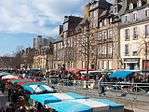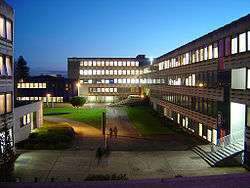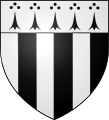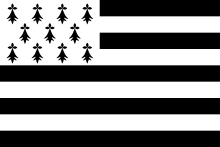Rennes
| Rennes Roazhon pronounced [ˈrwaːzən] | |||||||||
|---|---|---|---|---|---|---|---|---|---|
Top to bottom, left to right : City hall, Marché des Lices, Rennes Metro, Esplanade Charles de Gaulle, Opera of Rennes by night, University of Rennes 2, Skyline of Rennes from Cathedral | |||||||||
| |||||||||
| Motto: Live in harmony (French: "Vivre en intelligence") | |||||||||
 Rennes | |||||||||
|
Location within Brittany region  Rennes | |||||||||
| Coordinates: 48°06′53″N 1°40′46″W / 48.1147°N 1.6794°WCoordinates: 48°06′53″N 1°40′46″W / 48.1147°N 1.6794°W | |||||||||
| Country | France | ||||||||
| Region | Brittany | ||||||||
| Department | Ille-et-Vilaine | ||||||||
| Arrondissement | Rennes | ||||||||
| Intercommunality | Rennes Métropole | ||||||||
| Government | |||||||||
| • Mayor (2014-2020) | Nathalie Appéré (PS) | ||||||||
| Area1 | 50.39 km2 (19.46 sq mi) | ||||||||
| Population (2013)2 | 211,373 | ||||||||
| • Density | 4,200/km2 (11,000/sq mi) | ||||||||
| Time zone | CET (UTC+1) | ||||||||
| • Summer (DST) | CEST (UTC+2) | ||||||||
| INSEE/Postal code | 35238 / 35000, 35200, 35700 | ||||||||
| Elevation |
20–74 m (66–243 ft) (avg. 30 m or 98 ft) | ||||||||
|
1 French Land Register data, which excludes lakes, ponds, glaciers > 1 km² (0.386 sq mi or 247 acres) and river estuaries. 2 Population without double counting: residents of multiple communes (e.g., students and military personnel) only counted once. | |||||||||
Rennes (French: [ʁɛn]; French: Rennes, Gallo: Resnn, Breton: Roazhon, Latin: Condate, Civitas Redonum) is a city in the east of Brittany in northwestern France at the confluence of the Ille and the Vilaine. Rennes is the capital of the region of Brittany, as well as the Ille-et-Vilaine department.
Rennes's history goes back more than 2,000 years, at a time when it was a small Gallic village named Condate. Together with Vannes and Nantes, it was one of the major cities of the historic province of Brittany and the ancient Duchy of Brittany. After the French Revolution, Rennes remained for most of its history a parliamentary, administrative and garrison city of the Kingdom of France.
Since the 1950s, Rennes has grown in importance through rural flight and its modern industrial development, partly automotive. The city developed extensive building plans to accommodate upwards of 200,000 inhabitants. During the 1980s, Rennes became one of the main centres in telecommunication and high technology industry. It is now a significant digital innovation centre in France.
In 2015, the city is the tenth largest in France, with a metropolitan area of about 700,000 inhabitants.[1] With more than 63,000 students in 2013, is also the eighth-largest university campus of France.[2] The inhabitants of Rennes are called Rennais, Rennaise in French. In 2012, l'Express named Rennes as "the most liveable city in France".[3]
History
Overall significance
Rennes is the administrative capital of the French department of Ille-et-Vilaine. Before the French Revolution, prior to the integration of the Duchy of Brittany into the Kingdom of France, Rennes was the capital of the duchy, with the other historical capitals of Brittany's Ducal period being Nantes and Vannes. It has a long history due to its location at the confluence of two rivers and its proximity to the bordering regions from which arose various challenges to the borders of Brittany.
Earliest history

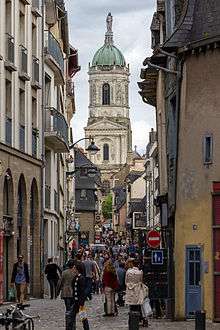
By the 2nd century BC the Gallic tribe known as the Redones had occupied a territory in eastern Brittany roughly equivalent to the modern department of Ille-et-Vilaine and had established their chief township at the confluence of the Ille and Vilaine rivers, the site of the modern city of Rennes. Although the tribe's name - from the Celtic root red cognate with ride suggesting the Redones were known for their horsemanship - would eventually default to their chief township ultimately yielding the name of the modern city of Rennes, the chief township of the Redones was contemporaneously referred to as Condate a Celtic term for confluence which was utilised to designate numerous towns in ancient Gaul.
Early in the 1st century BC, the Redones adopted the Greek and Roman practice of issuing coinage,[4] adapting the widely imitated gold staters of Philip II of Macedon, in the characteristic Celtic coin metal alloy called billon. Without inscriptions, as the Celtic practice was, the Redones coinage features a charioteer whose pony has a human head. Large hoards of their coins were unearthed in the "treasure of Amanlis" found in June 1835 and that of Saint-Jacques-de-la-Lande, discovered in February 1941. The museum at Rennes contains a large representative collection.
In 57 BC the Redones joined the Gaulish coalition against Rome which was suppressed by Crassus. In 56 BC Roman emissaries were held hostage by the Redones causing Julius Caesar to intervene in Armorica suppressing the rebels, and the following year to cross the Channel to discourage further support of the Redones by the Britons. In 52 BC, the Redones responded to the call of Vercingetorix to furnish a large contingent of warriors.[5]
Roman era
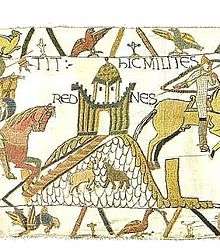
It was subsequent to its Roman occupation that the chief township of the Redones became known as Condate Riedonum - alternately Civitas Riedonum - the second element, referring to the Redones tribe who had founded it, ultimately yielding the name of the modern city of Rennes. The oldest known Rennais is Titus Flavius Postuminus, known to us from his steles found in Rennes in 1969. As indicated by his name, he would have been born under the Flavian dynasty, under the reign of Titus, i.e. between 79 and 81 AD. One of the steles tells us, in Latin, that he took charge over all the public affairs in the Civitas Riedonum. He was twice duumvir and flamen for life for Mars Mullo.
During the Roman era, the strategic position of the town contributed to its importance. To the west the principal Roman route, via Osismii, stretched from Condate Riedonum to Vorgium (modern Carhaix).
In the year 275, the threat of barbarians led to the erection of a robust brick wall around Rennes. Threatened by the danger of the peasant marauders designated as bagaudae in the final days of the Roman Empire in the 5th century, the Armorican peninsula, including Brittany and therefore Rennes, constituted the last stronghold of the western Roman Empire with the Armorican Romans invincible against Clovis I, who occupied most of Alamans, then the Visigoths.
The Holy See of Rennes had been established by 453, with a church having occupied the site of the current Rennes Cathedral since the start of the 6th century. One of the earliest bishops of Rennes: Melaine - who would become the city's patron saint - played an important role in the peace treaty between the Franks and the Armoricans in the year 497. He famously declared "Il faut faire la paix entre chrétiens" ("Peace must be made between Christians").
Middle Ages
From the 5th century, Bretons occupied the western part of the Armorican peninsula, which was resultantly known as Brittany (i.e. Little Britain), while the Franks took the rest of Armorica. To contain the expansion and avoid Breton incursions, the Carolingians instituted a Breton March or frontier province, composed of the counties of Rennes, Nantes and Vannes. These marches were entirely absorbed by the Kingdom of Brittany in the 9th century, with Rennes becoming fully Breton in 851. Throughout Brittany's existence as an independent state - first as a kingdom and then as a duchy - Rennes generally was considered to be one of three cities acting as the territory's capital, the others being Nantes and Vannes, with Rennes Cathedral being the coronation site for the dukes of Brittany.
During the Breton War of Succession (1356–57) Rennes was laid siege to by Henry of Grosmont (duke of Lancaster), cousin of the English king, but Bertrand du Guesclin penetrated the city and commandeered the resistance with ultimate victory. After nearly a year, Lancaster abandoned the English siege in 1357.
In 1491, the French army of Charles VIII, led by General Louis II de la Trémoille, unsuccessfully attacked Rennes. Brittany having already capitulated elsewhere, Rennes alone resisted. The defenders of Rennes were determined to resist to the death, but the Duchess Anne of Brittany chose instead to negotiate. The resulting treaty of Rennes of 15 November 1491 dictated her marriage to Charles VIII and brought Brittany into the French kingdom. Anne zealously guarded Brittany's autonomy and the treaty promised that justice would continue to be dispensed according to practices, usages and customs maintained and observed heretofore. Furthermore, he promised the continuation of the Parlement of Brittany which met in February–April 1493, September 1494 and September 1495.[6]
In 1720, a major fire destroyed all timber framing houses in the northern part of the city. The rebuilding was made of stone, on a grid plan.
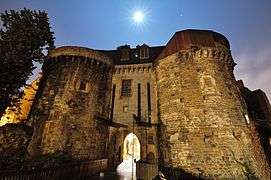 Mordelles Gates (Portes mordelaises), built in 1440, served as the principal entry to the town during the Middle Ages.
Mordelles Gates (Portes mordelaises), built in 1440, served as the principal entry to the town during the Middle Ages.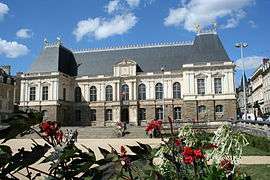 Parlement of Brittany, built 1618–1655.
Parlement of Brittany, built 1618–1655.- Old style streets in Rennes
- New style streets in Rennes, after the 1720s fire.
19th, 20th and 21st centuries
In 1857, Rennes railway station was built, which gradually led to the southward sprawl of the town. In 1899, Alfred Dreyfus' second trial in Rennes caused a national sensation.
With several faculties of the University of Brittany having transferred from Nantes to Rennes beginning with the law school in 1730, the full-fledged University of Rennes began operation in 1885 (although it was not so named until 1896 rather being referred to as a Conseil des facultés).
During the Second World War, Rennes suffered heavy damage from just three German aircraft which hit an ammunition train parked alongside French and British troop trains and near a refugee train on the yard: 1,000 died. The next day, 18 June 1940, German troops entered the city. Later, Rennes endured heavy bombing by the US and Royal Air Forces in March and May 1943, and again in June 1944, causing hundreds of deaths. Rennes contained a German transit POW camp and a POW hospital which contained many of the paratroopers captured on D-Day. Patton's army freed the capital of Brittany on 4 August, as retreating German troops blew up the bridges behind them, adding further damage. About 50,000 German prisoners were kept in four camps, in a city of only about 100,000 inhabitants at the time.
From 1954 onward, the city developed extensive building plans to accommodate upwards of 220,000 inhabitants,[7] helping it become the second fastest-growing city in France, after Toulouse (1999 census).
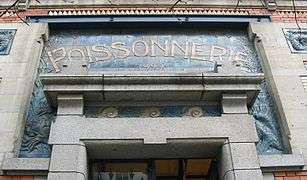 Entry to the former fish market at Les Halles Centrales, south of La Vilaine, from 1922. Now a contemporary art museum.
Entry to the former fish market at Les Halles Centrales, south of La Vilaine, from 1922. Now a contemporary art museum.- Banks of the Vilaine.
- Le Palais du Commerce at Place de la République.
- Lycée Zola, where Alfred Dreyfus' trial took place in 1899
Administration
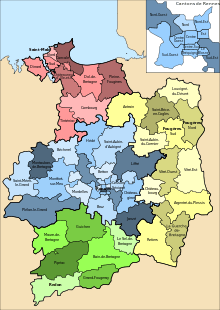
Rennes is divided into 11 cantons:
- Canton of Rennes-Brequigny (15,397 inhabitants)
- Canton of Rennes-Centre (19,017 inhabitants)
- Canton of Rennes-Centre-Ouest (21,264 inhabitants)
- Canton of Rennes-Centre-Sud (15,774 inhabitants)
- Canton of Rennes-Est (20,323 inhabitants)
- Canton of Rennes-le-Blosne (21,151 inhabitants)
- Canton of Rennes-Nord (21,845 inhabitants)
- Canton of Rennes-Nord-Est (18,224 inhabitants)
- Canton of Rennes-Nord-Ouest, which includes parts of Rennes but also the communes of Gévezé, Pacé and Parthenay-de-Bretagne (28,130 inhabitants)
- Canton of Rennes-Sud-Est, which includes parts of Rennes and the communes of Chantepie and Vern-sur-Seiche (33,459 inhabitants)
- Canton of Rennes-Sud-Ouest, which includes parts of Rennes and the communes of Saint-Jacques-de-la-Lande and Vezin-le-Coquet (28,707 inhabitants)
Since the 2008 cantonal elections, all eleven cantons are held by Socialists or their allies. The right held Rennes-Nord-Ouest until 2008.

Rennes is divided into 12 quarters:
- Le Centre
- Thabor/Saint Hélier
- Bourg l'Évêque-Moulin du Comte
- Saint-Martin
- Maurepas-Patton-Bellangerais
- Jeanne d'Arc-Longs-Champs-Beaulieu
- Francisco Ferrer-Landry-Poterie
- Sud Gare
- Cleunay-Arsenal-Redon
- Villejean-Beauregard
- Le Blosne
- Bréquigny
Mayors
The current mayor of Rennes is Nathalie Appéré. A member of the Socialist Party, she replaced retiring Socialist incumbent Daniel Delaveau, in office from 2008 to 2014.
- Edmond Hervé (b. 1942), Socialist mayor from 1977 to 2008;
- Henri Fréville (1905–1987), mayor MRP from 1953 to 1977;
- Eugène Quessot (1882–1949), interim mayor from 15 July 1947 until 26 October 1947;
- Yves Milon (1897–1987), mayor RPF from 1944 to 1953.
Among previous well-known mayors are:
- Jean Janvier (1859–1923), from 1908 to 1923;
- Edgar Le Bastard (1836–1891), from 1880 to 1891;
- Toussaint-François Rallier du Baty (1665–1734) from 1695 to 1734.
The mairie (city hall) is right in the centre of Rennes.
National representation
The French Prison Service operates the Centre pénitentiaire de Rennes, the largest women's prison in France.[8]
Geography
The ancient centre of the town is built on a hill, with the north side being more elevated than the south side. It is at the confluence of two rivers: the Ille and the Vilaine.
Rennes is located on the European atlantic arc, 50 km from the English Channel (near Saint-Malo, Dinard and Mont Saint-Michel).
Rennes has the distinction of having a significant Green Belt around its ring road. This Green Belt is a protected area between the city proper (rather dense) and the rest of its urban area (rather rural).
Climate
Rennes features an oceanic climate with mild winters and warm summers. Precipitation in Rennes is considerably less abundant than in the western parts of Brittany, reaching only half of the levels of, e.g., the city of Quimper, which makes rainfall in Rennes comparable to the levels of larger parts of western Germany. Sunshine hours range between 1,700 and 1,850 annually, which is about the amount of sunshine received by the city of Lausanne.
| Climate data for Rennes, Brittany | |||||||||||||
|---|---|---|---|---|---|---|---|---|---|---|---|---|---|
| Month | Jan | Feb | Mar | Apr | May | Jun | Jul | Aug | Sep | Oct | Nov | Dec | Year |
| Record high °C (°F) | 16.8 (62.2) |
19.8 (67.6) |
23.1 (73.6) |
28.7 (83.7) |
30.8 (87.4) |
36.3 (97.3) |
38.3 (100.9) |
39.5 (103.1) |
34.8 (94.6) |
30.0 (86) |
21.4 (70.5) |
17.8 (64) |
39.5 (103.1) |
| Average high °C (°F) | 8.7 (47.7) |
9.6 (49.3) |
12.7 (54.9) |
15.2 (59.4) |
18.9 (66) |
22.2 (72) |
24.5 (76.1) |
24.3 (75.7) |
21.6 (70.9) |
17.0 (62.6) |
12.1 (53.8) |
9.1 (48.4) |
16.4 (61.5) |
| Average low °C (°F) | 3.0 (37.4) |
2.6 (36.7) |
4.5 (40.1) |
5.9 (42.6) |
9.3 (48.7) |
11.9 (53.4) |
13.8 (56.8) |
13.7 (56.7) |
11.4 (52.5) |
9.1 (48.4) |
5.5 (41.9) |
3.3 (37.9) |
7.9 (46.2) |
| Record low °C (°F) | −14.7 (5.5) |
−11.2 (11.8) |
−7.3 (18.9) |
−3.2 (26.2) |
−1.2 (29.8) |
2.2 (36) |
5.5 (41.9) |
4.0 (39.2) |
1.9 (35.4) |
−4.6 (23.7) |
−7.5 (18.5) |
−12.6 (9.3) |
−14.7 (5.5) |
| Average precipitation mm (inches) | 67.6 (2.661) |
49.1 (1.933) |
51.6 (2.031) |
50.9 (2.004) |
67.2 (2.646) |
46.7 (1.839) |
49.1 (1.933) |
37.8 (1.488) |
59.0 (2.323) |
74.8 (2.945) |
67.5 (2.657) |
72.7 (2.862) |
694.0 (27.323) |
| Average precipitation days | 11.5 | 9.4 | 9.8 | 9.9 | 9.8 | 7.3 | 7.3 | 6.4 | 7.7 | 11.1 | 11.7 | 12.4 | 114.4 |
| Average snowy days | 2.1 | 2.6 | 1.5 | 0.6 | 0.0 | 0.0 | 0.0 | 0.0 | 0.0 | 0.0 | 0.7 | 1.7 | 9.2 |
| Average relative humidity (%) | 87 | 83 | 79 | 76 | 77 | 75 | 75 | 76 | 80 | 85 | 87 | 87 | 80.6 |
| Mean monthly sunshine hours | 69.1 | 87.2 | 128.4 | 162.7 | 191.2 | 217.3 | 210.7 | 205.5 | 177.8 | 117.5 | 81.3 | 68.6 | 1,717.1 |
| Source #1: Météo France[9][10] | |||||||||||||
| Source #2: Infoclimat.fr (humidity, snowy days 1961–1990)[11] | |||||||||||||
Population
In 2013, the inner population of the city was of 211,373 inhabitants, the Rennes intercommunal structure connecting Rennes with 42 nearby suburbs (named Rennes Métropole) counted 426,502 inhabitants and the metropolitan area counted 700,675 inhabitants.
Rennes has the second fastest-growing metropolitan area in France after Toulouse and before Montpellier, Bordeaux and Nantes.
The inhabitants of Rennes are called Rennais in French.
| Historical population | ||||||||||||||||||||||||||||||||||||||||||||||||||||||||||||||||||||||||||||||||||||||||||||||||||||||||||||||||||||||||||||||
|---|---|---|---|---|---|---|---|---|---|---|---|---|---|---|---|---|---|---|---|---|---|---|---|---|---|---|---|---|---|---|---|---|---|---|---|---|---|---|---|---|---|---|---|---|---|---|---|---|---|---|---|---|---|---|---|---|---|---|---|---|---|---|---|---|---|---|---|---|---|---|---|---|---|---|---|---|---|---|---|---|---|---|---|---|---|---|---|---|---|---|---|---|---|---|---|---|---|---|---|---|---|---|---|---|---|---|---|---|---|---|---|---|---|---|---|---|---|---|---|---|---|---|---|---|---|---|
|
|
|
| |||||||||||||||||||||||||||||||||||||||||||||||||||||||||||||||||||||||||||||||||||||||||||||||||||||||||||||||||||||||||||
Sights
Rennes is classified as a city of art and history.
Historic centre
The historic centre is located on the former plan of the ramparts. There is a difference between the northern city centre and the southern city centre due to the 1720 fire, which destroyed most of the timber framed houses in the northern part of the city. The rebuilding was done in stone, on a grid plan. The southern part, the poorest at this time, was not rebuilt.
Due to the presence of the parlement de Bretagne, many "hôtels particuliers" were built in the northern part, the richest in the 18th century. Most of the monuments historiques can be found there.
Colourful traditional half-timbered houses are situated primarily along the roads of Saint-Sauveur, Saint-Georges, de Saint-Malo, Saint-Guillaume, des Dames, du Chapitre, Vasselot, Saint-Michel, de la Psallette and around the plazas of Champ-Jacquet, des Lices, Saint-Anne and Rallier-du-Baty.
The Parlement de Bretagne and city hall area
The Parlement de Bretagne (Administrative and judicial centre of Brittany, Breton: Breujoù Breizh) is the most famous 17th century building in Rennes. It was rebuilt after a terrible fire in 1994 that may have been caused by a flare fired by a protester during a demonstration. It houses the Rennes Court of Appeal. The plaza around is built on the classical architecture.
On the west, the Place de la Mairie (City Hall Plaza, Plasenn Ti Kêr) :
- City Hall
- Opera
On the east, at the end of the Rue Saint-Georges with traditional half-timbered houses :
- 1920s Saint George Municipal Pool, with mosaics
- Saint George Palace, and its garden
On the south-east :
- Saint-Germain square
- Saint-Germain Church
- Saint-Germain footbridge, 20th century wood and metal construction to link the plaza with Émile Zola Quay, across the Vilaine River.
 Saint Germain's church
Saint Germain's church- Opera of Rennes
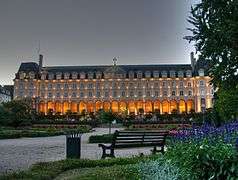 Saint Georges Palace
Saint Georges Palace Rennes's city hall
Rennes's city hall
The Place des Lices and cathedral area
The Place des Lices is lined by hôtels particuliers with the place Railler-du-Baty, is the location of the weekly big market, the marché des Lices.
Near the Rennes Cathedral (cathédrale Saint-Pierre de Rennes) is the Rue du Chapitre :
- Hôtel de Blossac
- There are 16th century polychrome wooden busts on the façade of 20, Rue du Chapitre.
On this era are the former St. Yves chapel, now the tourism office and a museum about the historical development of Rennes and the Basilica Saint-Sauveur
- Place des Lices with the roof top of Les Halles Martenot seen in on the left, and the hôtels particuliers on the right.
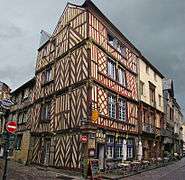 Rue du Chapitre
Rue du Chapitre- Gate of the Hôtel de Blossac
 Basilique Saint-Sauveur
Basilique Saint-Sauveur
Remains of the ramparts
Built from the 3rd to the 12th centuries, the ramparts were largely destroyed between the beginning of the 16th century and the 1860s.
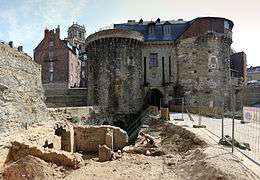 Portes mordelaises. The street crossing this gate comes from the Place des Lices and ends at the cathedral
Portes mordelaises. The street crossing this gate comes from the Place des Lices and ends at the cathedral Tour Duchesne
Tour Duchesne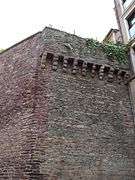 Place Railler-du-Baty
Place Railler-du-Baty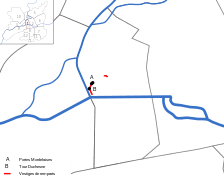 Map of the remaining ramparts in Rennes
Map of the remaining ramparts in Rennes
Place Saint-Anne area
Place Saint-Anne (Plasenn Santez-Anna)
- Saint-Aubin Church, built in the beginning of the 20th century
- Location of a former 14th century hospital
- Jacobite convent, the futur convention centre (2018)
South-western, La Rue Saint-Michel nicknamed Rue de La Soif (Road of Thirst) because there are bars all along this street.
South-eastern, the Champ-Jacquet square, with Renaissance buildings and a statue of mayor Jean Leperdit ripping up a conscription list.
- Place Saint-Anne
 Jacobite convent, vieved from the Place Saint-Anne
Jacobite convent, vieved from the Place Saint-Anne- Saint-Michel street
- Medieval houses at Champ-Jacquet
East : Thabor park area
Area of Saint-Melaine square
- Notre-Dame-en-Saint-Melaine basilica,
- Tower and transept from the 11th century Benedictine abbey of Saint-Melaine
- 14th century Gothic arcades
- 17th century colonnade
- Bell tower topped with a gilded Virgin Mary (19th century)
- 17th century cloister
Jardin botanique du Thabor (formal French garden, orangerie, rose garden, aviary) a botanical garden on 10 hectares of land, built between 1860 and 1867.
17th century promenade "la Motte à Madame", and a monumental stairway overlooking the Rue de Paris entrance to the Thabor.
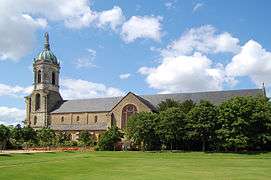 Notre-Dame-en-Saint-Melaine basilica, viewed from the parc du Thabor
Notre-Dame-en-Saint-Melaine basilica, viewed from the parc du Thabor- Main gate of the parc du Thabor
- Rue de Paris Thabor entrance
South city centre
The south city centre is a mix of old buildings and 19th and 20th centuries constructions.
- Maison des Carmes
- Lycée Zola
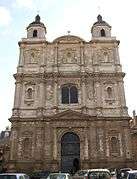 Toussaints church
Toussaints church- Palais du commerce
South of the Vilaine
The Fine Arts Museum is situated on Quai Émile Zola, by the Vilaine River.
Les Champs Libres is a building on Esplanade Charles de Gaulle, and was designed by the architect Christian de Portzamparc. It houses the Brittany Museum (Musée de Bretagne), the regional library Bibliothèque de Rennes Métropole with six floors, and the Espace des Sciences science centre with a planetarium.
At Place Honoré Commeurec is Les Halles Centrales, a covered market from 1922, with one part converted into contemporary art gallery.
The Mercure Hotel is located in a restored building on Rue du Pré-Botté, which was the prior location of Ouest-Éclair, and then of Ouest-France, a premier daily regional newspaper.
There are large mills at Rue Duhamel, constructed on each side of the south branch of the Vilaine in 1895 and 1902.
Other sights
To the northwest of Rennes, near Rue de Saint-Malo are the locks of the Canal d'Ille-et-Rance of 1843.
There are two halls of the printer, Oberthür, built by Marthenot between 1870 and 1895 on Rue de Paris in the eastern part of the city. Oberthür Park is the second biggest garden in the city.
The 17th century manor of Haute-Chalais, a granite château, is situated to the south of the city in Blosne Quarter (Bréquigny).
Parks and gardens
- Gayeulles parc
- Square of Motte.
- Mail Mitterrand
- Thabor parc
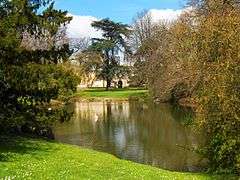 Oberthur parc
Oberthur parc Saint-Georges garden.
Saint-Georges garden.
Parc du Thabor contains a compact but significant botanical garden, the Jardin botanique du Thabor. The University of Rennes 1, with a campus in the city's eastern section, also contains a botanical garden and collections (the Jardin botanique de l'Université de Rennes).
Economy
Local economy include car manufacturing, telecommunications, digital sector and agrofood.
PSA Peugeot Citroën, currently the largest private employer in the metropolitan area of Rennes, opened a manufacturing plant at La Janais in Chartres-de-Bretagne in 1961. The ITC firm Orange R&D (ex-France Telecom) is the second largest local employer with 3,800 people. Technicolor, one of the biggest firms in TV and cinema broadcasting in the world employs over 500 people.
In a few years, Rennes became one of the main centres in high technology industry and digital. The city hosts one of the first Technopoles established in France : Rennes Atalante which employs over 20,000 people.
Rennes is the 2nd concentration of digital and ITC firms in France after Paris (with well-known companies and startups like Atos, SFR, Neosoft, Orange S.A., France Telecom, Envivio, Thomson Video Networks, Golaem, Technicolor R&D, Regionsjob, Capgemini, OVH, Dassault Systèmes, Delta Dore, Canon, Artefacto, Enensys Technologies, Astellia, Mitsubishi Electric R&D Europe, Digitaleo, Alcatel-Lucent, Kelbillet, Texas Instruments, NXP, Sopra Group, Niji, Thales, Nemeus or Logica). Rennes was one of the first French cities to receive the French Tech label in November 2014. Moreover, Rennes hosts the 3rd public research potential in digital and ITC sectors in France, after Paris and Grenoble, with 3,000 people working in 10 laboratories, like well-known IRISA, IETR, IRMAR, DGA-MI (cyberdefense), SATIE, etc. It is also the 3rd innovation potential in agrofood French industry with lots of firms in this field (Lactalis, Triballat Sojasun, Coralis, Panavi, Bridor, Claude Léger, Loïc Raison, Groupe Roullier, Sanders, etc.), an agro campus (Agrocampus Ouest) and a big international and professional expo, the Space (every year in September).
Other large firms located in Rennes include the restaurant conglomerate Groupe Le Duff (owners of Brioche Dorée, Bruegger's, La Madeleine, Mimi's Cafe, Timothy's World Coffee[12]), the first French newspaper Ouest France (800,000 daily copies) and Samsic Service (cleanliness, industrial safety, job search, etc.).
Culture


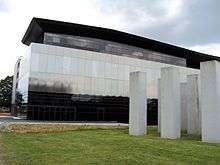
Rennes is known to be one of the most festive cities of France. It invests heavily in arts and culture and a number of its festivals (such as the music festival Les Transmusicales, Les Tombées de la Nuit, Mythos, Stunfest (fighting game competition) and Travelling (a cinematic festival)) are well known throughout France. During the 80's, Rennes was often cited as the French town of rock ans new wave music.[13]
Concerts hall
Rennes is well equipped in musical facilities :
- The MusikHall, for large shows (near the airport). (7,000 seats)
- Le Liberté, dedicated to major cultural events and touring shows. (5,300 seats)
- La Cité, dedicated to contemporary musics & locals artists. (1,150 seats)
- L'Etage (Le Liberté), dedicated to contemporary musics & locals artists. (900 seats)
- Rennes's Opera House (650 seats) and National Theatre of Brittany, TNB in French (Vilar room, 950 seats) for Brittany orchestra.
- The Ubu, an associative concert hall. (500 seats)
- L'Antipode MJC, which also an art centre. (500 seats)
Museums and exhibitions places
There are also five museums in Rennes:
- Musée des Beaux Arts (Museum of Fine Arts of Rennes). This art museum hold many works by the sculptor Pierre Charles Lenoir
- Musée de Bretagne (Museum of Brittany) at the Champs Libres, together with the 'espace of sciences' and a planetarium.
- Museum of Farming and Rennes Countryside at la Bintinais, south of Rennes.
- Musée des Transmissions (Museum of Broadcasting) at Cesson-Sévigné, east of Rennes centre.
- FRAC Bretagne Fond Régional d'Art contemporain (Regional Fund for Contemporary Art).
In addition to this list, there is art facilities, such as 40mcube exhibition space or the centre for contemporary art La Criée.
There is also miscellaneous cultural places: the dance dedicated place the Triange, two "Art et Essai" - art house cinemas - cinemas called l'Arvor and Cine TNB. Remark that the surrounding citys house many other cultural places.
Media
Rennes was one of the first towns in France to have its own local television channel 'TV Rennes', created in 1987.
Rennes has also local radio stations (Hit West, Radio Campus, Canal B, Radio Caroline, Radio Rennes, Radio Laser) and local newspapers or magazines (Ouest-France, Le Mensuel de Rennes, Place Publique, 20 Minutes Rennes).
Local culture
Breton language
In Brittany, two regional languages are spoken: Breton and Gallo. In and around Rennes, Gallo was traditionally spoken as a local language, but Breton has always been spoken by regional migrants coming from the western part of the region.
Nowadays, the Breton language is taught in one Diwan school, some bilingual public and Catholic schools, in evening courses, and in university.[14]
The municipality launched a linguistic plan through Ya d'ar brezhoneg on 24 January 2008.
In 2008, 2.87% of primary school children were enrolled in bilingual primary schools, and the number of pupils enrolled in these schools is steadily growing.[15]
Local food
Specialties from Rennes include:
- Galette
- Galette-saucisse
- Crêpe
- Cider
Many other Breton specialties (seafood, milk, vegetables, cheese, meat) are seen at the Marché des Lices, a weekly market held every Saturday morning (one of the most important markets in France).
Education

The Rennes agglomeration has a large student population (around 63,000).
The city has two main universities; Université de Rennes 1, which offers courses in science, technology, medicine, philosophy, law, management and economics and Université Rennes 2, which has courses in the arts, literature, languages, communication, human and social sciences and sport. The official website of Université Rennes 2 identifies that facility as "the largest research and higher learning institution in Arts, Literature, Languages, Social Sciences and Humanities in the West of France."
There are a few École Supérieures in Rennes, like the École Normale Supérieure de Cachan (which has a branch on the Ker Lann campus, just outside Rennes), the Institut d'études politiques de Rennes or the ESC Rennes School of Business.
There is also branches of École Supérieure d'Électricité – Supélec and Telecom Bretagne in the east of the city (Cesson-Sévigné), a campus of the École pour l'informatique et les nouvelles technologies and the grande école Institut National des Sciences Appliquées, which is next to the "École Nationale Supérieure de Chimie de Rennes".
The computer science and applied mathematics research institute, IRISA, is located on the campus of the Université des Sciences, nearby Cesson-Sévigné. The Délégation Générale pour l'Armement (defence procurement agency) operates the CELAR research centre, dedicated to electronics and computing, in Bruz, a neighbouring town.
Catholic University of Rennes (Institut Catholique de Rennes) is a Catholic university founded in 1989.
The city is also home to an American study abroad program for high school students, School Year Abroad, in which students are immersed in French culture through five classes in the language and a nine-month home stay.[16]
The École Compleméntaire Japonaise de Rennes (レンヌ補習授業校 Rennu Hoshū Jugyō Kō), a part-time Japanese supplementary school, is held in the Collège Anne de Bretagne in Rennes.[17]
Sport
Football club
- Rennes is home to Stade Rennais F.C., who plays in Ligue 1 at the Roazhon Park stadium.
Handball
- Cesson-Sévigné is home to Cesson-Rennes-Métropole handball, who plays in division 1.
Road bicycle
- Rennes is home to Fortuneo-Vital Concept (UCI Team Code: BSE), a professional cycling team.
Rugby
- Rennes is home to Stade Rennais Rugby, a women's rugby team who plays in Championnat de France de rugby à XV féminin, which is the top national competition for women's rugby union football clubs in France.
Transport
.jpg)


Rennes has well-developed national road, rail and air links.
Public transport
Local transport is based primarily on an extensive bus network (65 lines) and a metro line that was inaugurated in March 2002 and cost €500 million to build. The driverless Rennes Metro (VAL) is 9.4 km (5.8 mi) in length and has 15 stations, including one designed by architect Norman Foster (La Poterie station). A second metro line is being planned, it should be operational by 2019, and the construction began in 2014.[18]
Cycling
Rennes provides other modes of local transport : a bike sharing system with 900 bicycles (named Vélostar). Rennes created the first system of modern French bike sharing (1998).
Roads
The city is an important hub of Brittany's motorway network and is surrounded by a ring road : the Rocade (national road 136). The construction of the bypass was started in 1968 and completed in 1999. It is 31 km (18.5 mi) long, it has 2 lanes each way (sometimes 3 lanes) and toll free. Many other expressways are connected to the Rennes ring road for local and regional service. By road, Saint-Malo can be reached in 45 minutes, Nantes in 1 hour, Brest in 2 hours and 30 minutes, Paris in 4 hours, Bordeaux in 5 hours and Bruxelles in 6 hours and 30 minutes.
Railway
Rennes has a major French railway station, the Gare de Rennes, opened in 1857. It is now two hours by TGV high speed train from Paris (this will be reduced to one hour and 30 minutes from 2017, after extension of the High Speed Rail Line[19]). Train service is available to other big cities in France such as Lyon, Marseille, Lille and Strasbourg. Rennes is also an important railway station for regional transport in Brittany. The TER Bretagne provide links to Saint-Malo, Nantes, Redon, Vitré, Saint-Brieuc, Vannes, Laval, Brest and many other regional cities. It is served by Gare station on the VAL Rennes Metro.
Airport
Rennes is served by Rennes Brittany Airport (Saint-Jacques), located 7 kilometres (4.3 mi) from the centre to the south-west in the commune Saint-Jacques-de-la-Lande.
It notably operates regular or seasonal flights to Paris-Charles de Gaulle, Lyon, Marseille, Nice, Toulouse, Barcelona, Palma de Mallorca, Rome-Fiumicino, Southampton, Dublin, Manchester, Amsterdam Schiphol (begins 2016), Madrid Barajas (begins 2016), Birmingham (begins 2016), London-City (begins 2016), London-Gatwick (begins 2016) and daily flights to London Southend Airport with Flybe.
Notable people
(by alphabetical order)
- Soazig Aaron (born 1949), writer
- Bertrand d'Argentré (1519–1590), jurist and historian, seneschal of Rennes in 1547 than head of the présidial court
- Georges Ernest Boulanger (1837–1891), general and politician born in Rennes
- Jean-Claude Bourlès (born 1937), writer traveler
- Maxime Daniel (born 1991), professional cyclist
- Madeleine Desroseaux (1873-1939), poet and novelist
- Félix Dujardin (1801-1860), Professor and Dean, University of Rennes, famous parasitologist
- Robin Guthrie (born 1962), musician
- Hélène Jégado (1803–1852), Serial poisoner executed in 1852
- Jacques Legrand (born 1946), mongologist
- Charles Vanel (1892-1989), actor born in Rennes.
- Malika Ménard (born 1987), Miss France 2010
- Louis Pérouas (1923–2011), priest and historian
- Francois-Henri Pinault (born 1962), Chairman and CEO of PPR.
- René Pleven (1901–1993), twice President of the Council of Ministers, born in Rennes.
- Pierre Robiquet (1780–1840), chemist member of Académie des Sciences, discover of among others codein, asparagin and alizarin
International relations
Twin towns – sister cities
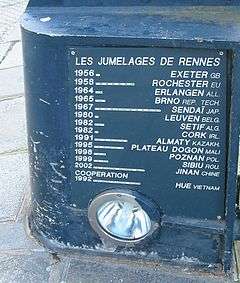
Rennes is twinned with:
(These twinned towns are inscribed on the bridge over the central canal of Rennes)
Within France
|
Pacts of cooperation
|
Sponsorship
|
In Rennes is also the only Institut Franco-Américain in France.
Broadcasting facilities
Cityscape
 Opera of Rennes
Opera of Rennes
- Horizons tower (100 metres/328 ft)
 New style city centre
New style city centre Notre-Dame en Saint-Mélaine church
Notre-Dame en Saint-Mélaine church
 Ouest-France building
Ouest-France building- Place Rallier du Baty
 Place de Bretagne
Place de Bretagne Windows of the Hôtel Racape de La Feuillée at Place des Lices
Windows of the Hôtel Racape de La Feuillée at Place des Lices- Marché des Lices, a market on weekly basis for local producers at Place des Lices
See also
References
- ↑ INSEE.fr
- ↑
- ↑
- ↑ "VSO 15 – Armorica, Redones coinage (Rennes) – Mail Bid Sale". Cgb.fr. 1 March 2002. Retrieved 22 July 2009.
- ↑ Caesar, Gallic Wars II.34; VII.75
- ↑ Barthélemy-Amédée Pocquet du Haut-Jussé, "A Political Concept of Louis XI: Subjection instead of Vassalage," in The Recovery of France in the fifteenth century, ed. P.S. Lewis, trans. G. F. Martin (New York: Harper Row, 1972): 196-215, pp. 210.
- ↑ "Insee – Populations légales 2008 – 35238-Rennes". Insee.fr. Retrieved 6 April 2011.
- ↑ "French pedophilia trial casts unsettling light on women sex offenders." Agence France Presse at The Island. 14 March 2005. Retrieved 19 March 2011.
- ↑ "Données climatiques de la station de Rennes" (in French). Meteo France. Retrieved 16 December 2014.
- ↑ "Climat France" (in French). Meteo France. Retrieved 16 December 2014.
- ↑ "Normes et records 1961-1990: Rennes-St Jacques (35) - altitude 36m" (in French). Infoclimat. Retrieved 16 December 2014.
- ↑
- ↑ http://www.dmagalerie.com/rennes-1981-08-avr-08-mai-2011
- ↑ (French) L'état de la langue bretonne dans l'enseignement en Ille-et-Vilaine (State of the Breton language in education in Ille-et-Vilaine) from Ofis ar Brezhoneg
- ↑ (French) Ofis ar Brezhoneg: Enseignement bilingue
- ↑ http://ayearinrennes.weebly.com/
- ↑ "欧州の補習授業校一覧(平成25年4月15日現在)" (Archive). Ministry of Education, Culture, Sports, Science and Technology (MEXT). Retrieved on May 10, 2014. "College Anne de Bretagne 15, rue de Martenot, 35000 RENNES"
- ↑ (French) Rennes.maville.com Le projet de nouvelle ligne du métro sur les rails
- ↑ "Rennes à 1h30 de Paris en 2014 – France – Toute l'actualité en France". France Info. Retrieved 6 April 2011.
- ↑ "British towns twinned with French towns [via WaybackMachine.com]". Archant Community Media Ltd. Archived from the original on 5 July 2013. Retrieved 2013-07-20.
- ↑ "Town twinning". Exeter City Council. Retrieved 16 September 2012.
- ↑ "City of Brno Foreign Relations - Statutory city of Brno" (in Czech). 2003 City of Brno. Retrieved 6 September 2011. External link in
|publisher=(help) - ↑ "Brno – Partnerská města" (in Czech). 2006–2009 City of Brno. Retrieved 17 July 2009. External link in
|publisher=(help) - ↑ Mulcahy, Noreen. "Cork - International Relations". Cork City Council. Archived from the original on 2013-05-18. Retrieved 2013-08-28.
- ↑ "Poznań - Miasta partnerskie". 1998–2013 Urząd Miasta Poznania (in Polish). City of Poznań. Archived from the original on 2013-09-23. Retrieved 2013-12-11.
- ↑ "Poznań Official Website – Twin Towns".
 (in Polish) 1998–2008 Urząd Miasta Poznania. Retrieved 29 November 2008.
(in Polish) 1998–2008 Urząd Miasta Poznania. Retrieved 29 November 2008.
External links
| Wikimedia Commons has media related to Rennes. |
| Wikivoyage has a travel guide for Rennes. |
| Look up Rennes in Wiktionary, the free dictionary. |
.jpg)
